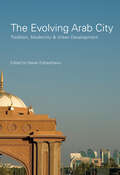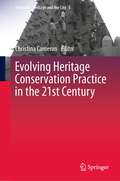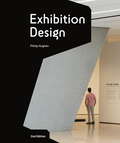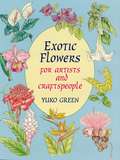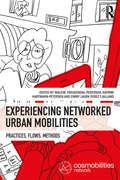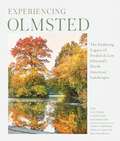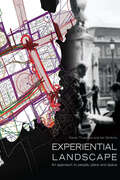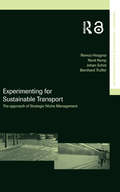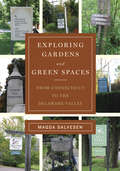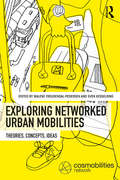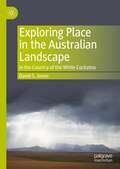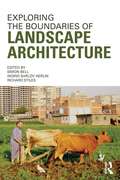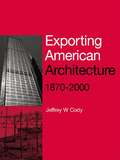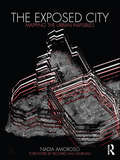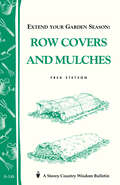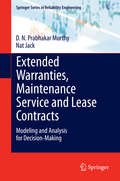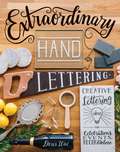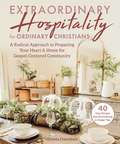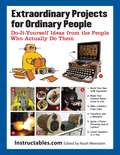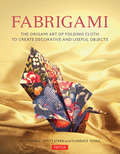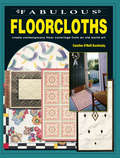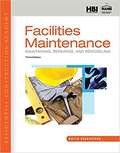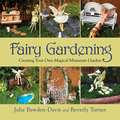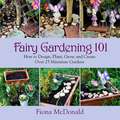- Table View
- List View
The Evolving Arab City: Tradition, Modernity and Urban Development (Planning, History and Environment Series)
by Yasser ElsheshtawyToday cities of the Arab world are subject to many of the same problems as other world cities, yet too often they are ignored in studies of urbanisation. This collection reveals the contrasts and similarities between older, traditional Arab cities and the newer oil-stimulated cities of the Gulf in their search for development and a place in the world order. The eight cities which form the core of the book – Rabat, Amman, Beirut, Kuwait, Manama, Doha, Abu Dhabi and Riyadh – provide a unique insight into today’s Middle Eastern city. Winner of The International Planning History Society (IPHS) Book Prize.
Evolving Heritage Conservation Practice in the 21st Century (Creativity, Heritage and the City #5)
by Christina CameronThis book focuses on current trends in cultural heritage conservation and their influence on heritage practice. Seen through the lenses of World Heritage, historic urban landscapes, heritage tourism, climate change or the nature/culture nexus, these challenges call for innovative approaches to protect and conserve our heritage places. The book brings together the voices of different stakeholders in the heritage conservation process, ranging from scholars, site managers and government officials to young professionals and students.
Exhibition Design Second Edition: An Introduction
by Philip HughesExhibition Design describes the skills needed to become an exhibition designer, including: developing a brief and working with clients; design principles for graphics, circulation, lighting, and accessibility; presenting ideas to clients; and the practicalities of production. A wealth of visual material includes photographs of completed exhibitions by world-renowned designers, concept drawings, computer renderings, charts and tables of information – all for a wide range of exhibitions around the world, permanent and temporary, including museums and galleries, visitor centres, brand experiences, festivals, and trade fairs. This second edition includes new examples, updated information on the latest digital technology, and expanded coverage of interactives and sound and film.
Exhibition Design Second Edition: An Introduction
by Philip HughesExhibition Design describes the skills needed to become an exhibition designer, including: developing a brief and working with clients; design principles for graphics, circulation, lighting, and accessibility; presenting ideas to clients; and the practicalities of production. A wealth of visual material includes photographs of completed exhibitions by world-renowned designers, concept drawings, computer renderings, charts and tables of information – all for a wide range of exhibitions around the world, permanent and temporary, including museums and galleries, visitor centres, brand experiences, festivals, and trade fairs. This second edition includes new examples, updated information on the latest digital technology, and expanded coverage of interactives and sound and film.
Exotic Flowers for Artists and Craftspeople (Dover Pictorial Archive)
by Yuko GreenThe lavish colors and exotic beauty of tropical flowers have long made them favorite subjects of artists and craftspeople. This splendid sourcebook of copyright-free illustrations offers workers in many arts and crafts a marvelous sampling of lovely blossoms from rain forests, jungles, and tropical regions around the world. Depicting blossoms from trees, shrubs, vines, and ornamental herbs, 135 accurately detailed drawings depict a host of superb specimens, as varied in size and shape as they are in natural habitat. Included are the Indian Coral Tree, Sausage Tree, Monkeypod, Shrimp Plant, Crown Flower, Blushing Bride, Cup of Gold, Bird of Paradise, African Tulip, Angel's Trumpet, Butterfly Hibiscus, Thimbleberry, King Protea, Crown of Thorns, Passion Flower, Rattle Shaker, Orchid Tree, Rose Apple, Gardenia, Candle Bush, Pincushion, Lipstick Plant, Orange Trumpet, Spider Lily, and over 100 other flowers.All are identified by their common and scientific names as well as by regions of origin. Ideal for adding dramatic accents to embroidery projects and textile patterns, for use in woodworking, leathercraft, metalwork, and a host of other crafts, this varied collection represents a superb resource for artists, illustrators, and anyone in need of striking floral decorations.
Experiencing Networked Urban Mobilities: Practices, Flows, Methods (Networked Urban Mobilities Series)
by Malene Freudendal-Pedersen Katrine Hartmann-Petersen Emmy Laura Perez FjallandExperiencing Networked Urban Mobilities looks at the different experiences of networked urban mobilities. While the focus in the first book is on conceptual and theory-driven perspective, this second volume emphasizes the empirical investigation of networked urban mobilities. This book is a resource for researchers interested in the field to gain easy access and overviews of different themes and approaches represented in the mobilities paradigm.
Experiencing Olmsted: The Enduring Legacy of Frederick Law Olmsted's North American Landscapes
by The Cultural Landscape Foundation Charles Birnbaum Dena Tasse-Winter Arleyn Levee200 Iconic Landscapes That Define North America Frederick Law Olmsted is the father of American landscape architecture. His firm, and the successor firms that sprung from it, worked through the nineteenth and twentieth centuries to shape some of our most beloved green spaces, including national, state, and city parks, suburban neighborhoods, and academic campuses. He is most famous for creating New York&’s Central and Prospect Parks, Stanford University&’s campus, and the Capitol Grounds. What is less known and surprising about his legacy is that he worked widely across North America. By highlighting 200 iconic landscapes, many of which are still open to the public today, Experiencing Olmsted brings a fresh approach to the firms&’ work and philosophy. It highlights not only grand city parks, but also other public venues born out of a desire for social equity. Olmsted was an early voice for parks as democratic spaces that could be reached on foot by a large percentage of any city&’s populace. He viewed parks as restorative places—what he termed &“the lungs of a city.&” Brimming with contemporary and archival photography as well as original drawings and plans, this truly remarkable record brings these places to vivid life.
Experiential Landscape: An Approach to People, Place and Space
by Kevin Thwaites Ian SimkinsExperiential Landscape offers new ways of looking at the relationship between people and the outdoor open spaces they use in their everyday lives. The book takes a holistic view of the relationship between humans and their environment, integrating experiential and spatial dimensions of the outdoors, and exploring the theory and application of environmental design disciplines, most notably landscape architecture and urban design. The book explores specific settings in which an experiential approach has been applied, setting out a vocabulary and methods of application, and offers new readings of experiential characteristics in site analysis and design. Offering readers a range of accessible mapping tools and details of what participative approaches mean in practice, this is a new, innovative and practical methodology. The book provides an invaluable resource for students, academics and practitioners and anyone seeking reflective but practical guidance on how to approach outdoor place-making or the analysis and design of everyday outdoor places.
Experimenting for Sustainable Transport: The Approach of Strategic Niche Management (Transport, Development and Sustainability Series)
by Johan Schot Remco Hoogma Rene Kemp Bernhard TrufferTechnological change is a central feature of modern societies and a powerful source for social change. There is an urgent task to direct these new technologies towards sustainability, but society lacks perspectives, instruments and policies to accomplish this. There is no blueprint for a sustainable future, and it is necessary to experiment with alternative paths that seem promising. Various new transport technologies promise to bring sustainability benefits. But as this book shows, important lessons are often overlooked because the experiments are not designed to challenge the basic assumptions about established patterns of transport choices. Learning how to organise the process of innovation implementation is essential if the maximum impact is to be achieved - it is here that strategic niche management offers new perspectives. The book uses a series of eight recent experiments with electric vehicles, carsharing schemes, bicycle pools and fleet management to illustrate the means by which technological change must be closely linked to social change if successful implementation is to take place. The basic divide between proponents of technological fixes and those in favour of behavioural change needs to be bridged, perhaps indicating a third way.
Exploring Gardens & Green Spaces: From Connecticut to the Delaware Valley
by Magda SalvesenAn illustrated guidebook to a rich array of 148 designed landscapes along the Northeast Corridor. Nestled all along the northeast corridor, a profusion of horticultural gems and designed landscapes beckons visitors, from celebrated formal parks, estates, and arboretums to less familiar--and often hard to find--gardens. This unique guidebook features 148 of them, providing readers with an incomparable resource for locating and exploring the region's green spaces--many with historic homes at their center. Whether large, sumptuous, and impressively maintained, or modest in size, budget, and staff, all have distinctive historical, artistic, and horticultural offerings that make them well worth a trip. Mt. Cuba Center and Winterthur in Delaware, Longwood Gardens in southeastern Pennsylvania, Grounds for Sculpture and the Leonard J. Buck Garden in New Jersey, the Humes Japanese Stroll Garden on Long Island, Stonecrop Gardens and Innisfree in the Hudson Valley, and Elizabeth Park and Hollister House in Connecticut are just a few of the great gardens highlighted. Featuring more than three hundred color photographs and twenty-nine maps, with a fund of practical information for each entry--including transportation, nearby eateries, and other sites of interest, Exploring Gardens and Green Spaces is a veritable tour guide at your fingertips, showcasing an array of gardens that await discovery.
Exploring Networked Urban Mobilities: Theories, Concepts, Ideas (Networked Urban Mobilities Series)
by Malene Freudendal-Pedersen Sven KesselringExploring Networked Urban Mobilities explores different conceptual and theoretical angles between social practices and urban environments, culture, infrastructures, technologies, and the politics of mobility. The book introduces the concept of networked urban mobilities and lays out a research agenda for the future of mobility studies. Each of the contributors represents a specific approach in the field and each article provides cutting-edge theoretical and conceptual reflections on the topic. Mobility here is understood as a heterogeneous phenomenon that shapes modern societies and cities by emerging in different dimensions: as physical, social, cultural, and digital mobilities.
Exploring Place in the Australian Landscape: In the Country of the White Cockatoo
by David S. JonesIncluded is a deep ethno-ecological and cross-cultural translation, that takes the reader through both the Western understanding of sense of place as well as the Australian Aboriginal understanding of Country. Both are different intellectual constructions of thoughts, values and ideologies, but which share numerous commonalities due to their archetypal meanings, feelings and values transmitted to humans.
Exploring the Boundaries of Landscape Architecture
by Simon Bell Ingrid Sarlöv Herlin Richard StilesWhat have cultural anthropologists, historical geographers, landscape ecologists and environmental artists got in common? Along with eight other disciplines, from domains as diverse as planning and design, the arts and humanities as well as the social and natural sciences, they are all fields of importance to the theory and practice of landscape architecture. In the context of the EU funded LE:NOTRE Project, carried out under the auspices of ECLAS, the European Council of Landscape Architecture Schools, international experts from a wide range of related fields were asked to reflect, each from their own perspective, on the interface between their discipline and landscape architecture. The resulting insights presented in this book represent an important contribution to the development the discipline of landscape architecture, as well as suggesting new ways in which future collaboration can help to create a greater interdisciplinary richness at a time when the awareness of the importance of the landscape is growing across a wide range of disciplines. Exploring the Boundaries of Landscape Architecture is the first systematic attempt to explore the territory at the boundaries of landscape architecture. It addresses academics, professionals and students, not just from landscape architecture but also from its neighbouring discipline, all of whom will benefit from a better understanding their areas of shared interest and the chance to develop a common language with which to converse.
Exporting American Architecture 1870-2000 (Planning, History and Environment Series)
by Jeffrey W. CodyThe export of American architecture began in the nineteenth century as a disjointed set of personal adventures and commercial initiatives. It continues today alongside the transfer of other aspects of American life and culture to most regions of the world. Jeffrey Cody explains how, why and where American architects, planners, building contractors and other actors have marketed American architecture overseas. In so doing he provides a historical perspective on the diffusion of American building technologies, architectural standards, construction methods and planning paradigms. Using previously undocumented examples and illustrations, he shows how steel-frame manufacturers shipped their products abroad enabling the erection of American-style skyscrapers worldwide by 1900 and how this phase was followed by similar initiatives by companies manufacturing concrete components.
The Exposed City: Mapping the Urban Invisibles
by Nadia AmorosoThere is a vast amount of information about a city which is invisible to the human eye – crime levels, transportation patterns, cell phone use and air quality to name just a few. If a city was able to be defined by these characteristics, what form would it take? How could it be mapped? Nadia Amoroso tackles these questions by taking statistical urban data and exploring how they could be transformed into innovative new maps. The "unseen" elements of the city are examined in groundbreaking images throughout the book, which are complemented by interviews with Winy Maas and James Corner, comments by Richard Saul Wurman, and sections by the SENSEable City Lab group and Mark Aubin, co-founder of Google Earth.
Extend Your Garden Season: Storey's Country Wisdom Bulletin A-148 (Storey Country Wisdom Bulletin Ser.)
by Fred StetsonSince 1973, Storey's Country Wisdom Bulletins have offered practical, hands-on instructions designed to help readers master dozens of country living skills quickly and easily. There are now more than 170 titles in this series, and their remarkable popularity reflects the common desire of country and city dwellers alike to cultivate personal independence in everyday life.
Extended Warranties, Maintenance Service and Lease Contracts
by D.N.Prabhakar Murthy Nat JackServing to unify the existing literature on extended warranties, maintenance service contracts and lease contracts, this book also presents a unique perspective on the topic focussed on cost analysis and decision-making from the perspectives of the parties involved. Using a game theoretic approach together with mathematical modelling, results are presented in an integrated manner with key topics that require further research highlighted in order to serve as a starting point for researchers (engineers and statisticians) who are interested in doing further work in these areas. Designed to assist practitioners (managers, engineers, applied statisticians) who are involved with extended warranties, maintenance service contracts and lease contracts, the book provides them with the models and techniques needed for proper cost analysis and effective decision-making, The book is also suitable for use as a reference text in industrial engineering, applied statistics, operations research and management.
Extraordinary Hand Lettering: Creative Lettering Ideas for Celebrations, Events, Decor, & More
by Doris WaiAre you a curious hand lettering beginner or long-time enthusiast looking to take your craft to the next level? Or are you a DIY guru or event planner wishing to breathe new life into a boring gift, event signage, or party décor? Extraordinary Hand Lettering opens your eyes to the endless possibilities in the world of creative lettering, showing you how to work with types of surfaces, such as wood, glass and acrylic, chalk, and even mirrors. First, learn the simple tools and tricks of hand lettering essentials—cursive and basic typefaces, creating balance and composition, and how to draw letters, as well as secret tips on what words you should choose to spotlight or shadow. Then, discover the lettering potentials of everyday items by transforming household objects or discarded items, such as old vintage mirrors, jewelry, and furniture, into a customized gift, unique decoration, quirky art piece, or stunning signage—all with the right lettering and choice of pen, pencil, or marker. For all DIY art-and-crafters, homemakers, and small business entrepreneurs, lettering is a versatile and necessary skill that can repurpose the old into something that is new, beautiful, and functional. Finally, draw inspirations from twelve whimsical projects suited for the girlie girl, the sophisticated man, or the modern minimalist. Combine the art of lettering and upcycling crafts to bring beauty into your everyday lifestyle.
Extraordinary Hospitality for Ordinary Christians: A Radical Approach to Preparing Your Heart & Home for Gospel-Centered Community
by Victoria DuerstockPrepare your heart and home to serve not only family and friends, but neighbors and strangers too! Make any space a haven of discipleship, connection, and comfort. As Christians, we sometimes forget the power of an open door to a lost world. Using our homes to live out our faith in the true model of the Great Commission is challenging in our busy, over-scheduled lives. But having a home that is always open and available is key to living in community with others and being missional in our thinking. In this beautiful and inspiring book, wife, mom, and interior design enthusiast Victoria Duerstock offers simple and inspiring ways to prepare our hearts and homes to be open to friends, neighbors, and strangers. You don't need an immaculate or professionally decorated home to be hospitable. In fact, there is beauty in being honest with others about our lived-in spaces, and great value in being humble enough to live life together in the midst of imperfection. But it'll be a blessing to you and to your guests to create a space that reflects the beauty, peace, and joy of life in Christ. Whether you have a tiny apartment or a big old farmhouse, you can learn how to: Declutter common areasBring hygge to your guest room (or even just to your couch, if that's all you've got!)Create a peaceful, welcoming atmosphereSchedule in regular housecleaningPrepare freezer meals for no-stress last minute dinners More importantly, be encouraged to have your heart in the right place, to engage in meaningful discussion with guests, and to take time to be a "Mary" in our works-driven "Martha" culture. Allow the Holy Spirit to overflow from your heart into your homes and community as you let your guard down and invite people into your lives.
Extraordinary Projects for Ordinary People: Do-It-Yourself Ideas from the People Who Actually Do Them
by Instructables. Com Noah WeinsteinCollected in this volume is a best-of selection from Instructables, reproduced for the first time outside of the web format, retaining all of the charm and ingenuity that make Instructables such a popular destination for internet users looking for new and fun projects designed by real people in an easy-to-digest way. <p><p> Hundreds of Instructables are included, ranging from practical projects like making a butcher block counter top or building solar panels to fun and unique ideas for realistic werewolf costumes or transportable camping hot tubs. The difficulty of the projects ranges from beginner on up, but all are guaranteed to raise a smile or a “Why didn’t I think of that?” <p> Numerous full-color pictures accompany each project, detailing each step of the process along the way. It’s an invitation to try a few yourself, and once you’re done, see if you don’t have a couple of ideas to share at Instructables.com.
Fabrigami
by Florence Temko Scott Wasserman Stern Jill StovallFabrigami is the art of folding fabrics to create three-dimensional objects ranging from the practical to the whimsical. Like paper, there are countless beautiful fabric designs to choose from, only fabric has the virtue of being extremely durable.Fabrigami began as origami legend Florence Temko's final project. Everyone knows that origami is the art of paper folding, but Temko had begun experimenting with folding fabric to make objects that are just as beautiful but more lasting than paper. Sadly, Temko passed away before the book was completed, but her collaborator, Jill Stovall, continued their work. Now, Stovall-with the help of Scott Stern, a rising young star of origami-brings Fabrigami to print for everyone to use and enjoy.This book begins by presenting instructions on how to treat fabric so it holds a shape when folded. Then Stovall shares a series of fun craft projects with simple origami-style diagrams that you can use to make a range of lovely objects, including: Fan-tastic Fold Earrings Evening Wine Coat Florence's Hexagon Box Cloth Kimono Card Pleated Peacock
Fabulous Floorcloths: Create Contemporary Floor Coverings from an Old World Art
by Caroline O'Neill KuchinskyCreate distinctive floor coverings to match your home's decor Canvas floorcloths are an inexpensive way to add style and beauty to any room in the house. Whether your style is contemporary or Victorian, elegant or whimsical, a custom-designed floorcloth will transform your ordinary floor into a work of art. And you can do it yourself - it's fun and surprisingly easy. In Fabulous Floorcloths you'll find projects for all skill levels - from the novice crafter to the experienced artist. The complete easy-to-follow instructions and step-by-step illustrations help you create exactly what you want. No more paying high prices for custom carpeting or area rugs - canvas floorcloths are inexpensive to make and long-lasting. Choose from the 15 projects included or design your own to suit your individual style. Techniques include: Stamping and veining Painting Stenciling Lattice Paper decoupage Paper and fabric applique Doily spray From "Rainbow Hopscotch" for the game room, "Victorian Lace" for the bedroom, or "Stained Glass" or "Santa Fe" for the family room, you'll find a floorcloth project to complement any decor.
Facilities Maintenance: Maintaining, Repairing, And Remodeling (Residential Construction Academy)
by Kevin StandifordCreated in partnership with the Home Builders Institute (HBI), the workforce development arm of the National Association of Home Builders (NAHB), the Residential Construction Academy Series is the only program based on the National Skill Standards for residential construction. Step-by-step illustrations and an easy-to-read writing style make RESIDENTIAL CONSTRUCTION ACADEMY: FACILITIES MAINTENANCE, 3RD the powerful tool readers need for any facilities maintenance course. This edition walks readers through a straightforward approach that describes common maintenance tasks in detail, like carpentry, wiring, groundskeeping, appliance repair, painting, plumbing, and HVAC. Enhanced chapters on basic math and blueprint reading give readers the most comprehensive training available. Plus, each section emphasizes safety and highlights the skills readers can build that employers are searching for. RESIDENTIAL CONSTRUCTION ACADEMY: FACILITIES MAINTENANCE, 3RD is the manual readers need to develop a solid foundation in facilities maintenance.
Fairy Gardening: Creating Your Own Magical Miniature Garden
by Beverly Turner Julie Bawden-DavisFairy gardens are enjoying an astonishing surge in popularity and now you can begin making your own enchanting miniature landscapes, complete with pint-sized accessories, diminutive plants, and quaint fairy figures. Gardeners Julie Bawden-Davis and Beverly Turner provide you with step-by-step instructions for creating a magical garden that will attract Thumbelina herself!Learn how to design, plant, accessorize, and care for your very own small corner of the world by following seven simple steps, including choosing the perfect container, planting luxurious pint-sized plants, decorating with properly scaled accessories, and telling a story through the delicate fairies you choose to inhabit your magical wonderland. Included are full-color photographs showcasing various types of fairy gardens and accessories, which are sure to inspire the designer in you! And best of all, these perennial gardens are perfect for the busy gardener, as they require less than ten minutes per week to maintain--this could be your new favorite hobby! For the inner child in us all, Fairy Gardening is sure to enchant both the novice and the experienced gardener who wishes to stir up Lilliputian flights of fancy.
Fairy Gardening 101: How to Design, Plant, Grow, and Create Over 25 Miniature Gardens
by Fiona McdonaldRelease your inner child and step into the fairy world by creating your own enchanted garden, no matter how much space you have! Fairy gardens are increasing in popularity and Fairy Gardening 101 provides you with all the information necessary to design, plant, and care for your very own miniature garden oasis. Author, artist, and fairy gardener extraordinaire Fiona McDonald introduces readers to the history of fairy gardens and then provides step-by-step instructions, photographs, and illustrations for you to follow-or draw inspiration from-when starting your own project.Learn which types of plants and containers are most successful for a fairy garden, as well as how to develop a focal point for your enchanted mini Eden. Fairy Gardening 101 also provides important information on caring for your garden, on designing gardens for both indoors and outside, on using artificial plants to make your garden last a lifetime, and much more! You'll also find inspirational photos from fairy gardeners around the globe as well as a list of suppliers. You don't need to be a master gardener or to have a particularly green thumb to successfully plant and maintain your tiny fairy garden. All you need is a few miniature plants, some thoughtfully placed accessories, a fairy or two, and a love of whimsy and imagination.
